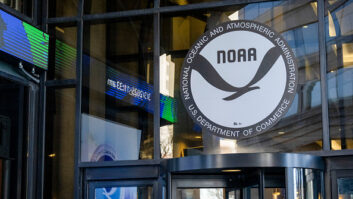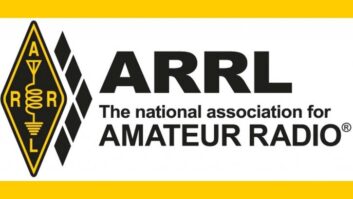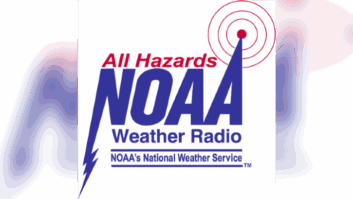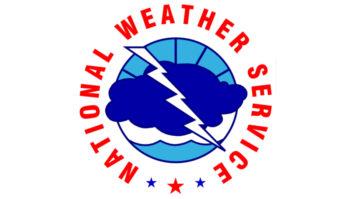Amateur radio has long been a “gateway” into the broadcast engineering trade. Many an engineer has found his way into broadcasting as a result of an interest in ham radio. The tubes and coils and capacitors of bygone AM days have given way to Raspberry Pis and various digital modes of today, but the connection and pathway into broadcast engineering remain. This account is a good, recent example of how amateur radio can still generate excitement and attract people into its ranks. – Ed.

When I was growing up in the small California town located in the San Gabriel Valley known as Temple City, my father introduced me to ham radio, aka amateur radio. In the evenings, we would go outside and sit in his Rebel Rambler that was parked in the driveway, and my dad would fire up his 2-meter (144 MHz) mobile unit.
He would quite often talk to longtime family friend and colleague Rudy Eleff, who lived about eight miles away from our house. Rudy was quite a talker, as I recall, and one evening my dad allowed me to work as a guest operator and speak to Rudy. When I did, my dad keyed the microphone and I said to Rudy, “My dad said that you talk too much.”
That was the first and last time my, dad let me talk through his ham rig. I still to this day laugh when I recall that first introduction into ham radio!
Well, many years passed, and in 1995, I was getting a renewed interest in getting my ham license. My colleague at work, George Sfair, KJ6TQ, was an operator who ran a weekly ham net and also taught a class to people interested in applying for a ham license. So I signed up for George’s course and took the required tests, and eventually got my tech license.
After that, I could not wait to get my first radio. My brother-in-law, Nick Vestuto, KM6LN, was also a ham, and to get me started, he gave me a 2-meter Alinco handheld transceiver. It was a lot of fun making radio contacts, and not too long after being given the 2-meter radio, George gave me a PK-88 packet terminal node controller (TNC) to allow me to operate packet radio.
I eventually bought a dual-band 2-meter/70-centimeter (440 MHz) rig that had many new capabilities, and I ran that radio for years. But as time went by, with family obligations and just being busy, I had limited time to get on the radio, and things faded away for a while … until a couple of years ago when I decided to get my ham gear up to an operating level again.
I have always had an interest in space and space exploration, and when I first got my ham license, I would attempt to reach the “MIR Space Station” as it passed overhead, but was never successful.
A SPACE ODYSSEY
When I got my gear back up and running again, I was reading quite a bit about the International Space Station (ISS) and the ARISS program. I found that the astronauts, many of whom are amateur radio operators, would get on the ham system onboard the spacecraft when they had free time and would speak to earthbound hams. That really caught my interest, so I began to investigate the frequencies used to uplink to and downlink from the ISS, as well as learning how to track it.
Using the Android app called “Heaven’s Above” or the web app at www.heavens-above.com, I could find out exactly when and where to look up to the sky to either track the ISS visually (at night, seeing it with the naked eye) or to track it with a directional antenna.
Once I knew the frequencies for a voice contact, I would track it using “Heaven’s Above.” I would set up in my driveway, and for my early contacts, I would only use a “rubber duck” antenna, but I could hit the radio on the ISS with only 5 watts. I never got a voice response, but I scanned up/down the 2-meter dial and found a data channel. It turns out the ISS also has a packet radio system as well, that allows you to “digipeat” up to the ISS and it will “digipeat” down to ground stations.
Once this was known, I brought out my old packet TNC that George gave me many years earlier. Unfortunately it did not work. So after practically changing every major component in that old PK-88 Packet TNC, I gave up on it and began to look for newer systems.
I found a great new TNC that costs $40 made by a company called Coastal ChipWorks (www.tnc-x.com/TNCPi.htm), a “TNC Pi2” that becomes a daughter board for a Raspberry Pi minicomputer. This is a kit, which takes about an hour to build, and when paired with a custom version of the terminal program “Minicom” that was modified by UK-based John Wiseman, G8BPQ, it creates a very powerful packet radio TNC.
So I purchased and built one of these kits. I initially had a couple of issues with “Minicom,” and after a few back-and-forth emails with John, I needed to grant John remote access into my Raspberry Pi to have him resolve the issue. John got in and found that it required a clean copy of Minicom be installed first, then his modified version over that for things to function properly.
With the software piece setup and tested correctly, it was time to connect the hardware. I built a dual-band “Yagi” antenna out of coat hangers to connect to my Yaesu FT-60 handheld transceiver. With all of those pieces working, it was time to try to “digipeat” through the International Space Station.
I set up in my driveway on a small table and used my mobile device to track the ISS. When I began to get close to the ISS pass time, I would begin sending data packets about one every 20 seconds.
CONTACT!
One difficulty with contacting the space station is that it is moving at 17,500 miles per hour, and most passes in North America are fairly low on the horizon and pretty short in duration. As such, you must be prepared and ready to move your antenna quickly as the ISS travels by. This is further complicated by the fact that a lot of other people are trying to do the very same thing, which may cause your signal to collide with theirs, causing it to become garbled.
After several attempts over a few days, I finally got a message up to the ISS and saw it come back down via the APRS network. This was very gratifying!
00:00:19:38 : KF6FES]CQ,RS0ISS*,DM04OG,qAR,N6DAN-2:]DM04og/Happy 60th NASA! via ISS
00:00:19:40 : RS0ISS]CQ,qAR,N6DAN-2:]ARISS – International Space Station
00:01:27:45 : RS0ISS]CQ,qAR,DH3SF-10:]ARISS – International Space Station
Shortly after this initial success, NASA was going to be celebrating 60 years in space in October 2018. They had planned a special SSTV (Slow Scan TV) event whereby they would transmit photos down from space. I participated and was fortunate to have been able to capture some of those photos too.
The great thing with amateur radio is that there are many modes of operation, so if you want to operate voice, you can. If you want to operate in one of the many digital modes, you can, or you can operate with any other mode you choose.
During this process, I met many helpful hams who guided me along the way, and was happy to find that the hobby is still very active with all different age groups from all over the world participating.
Brian Clark has been a broadcast engineer in the Los Angeles area for 35 years, much of that time at KIIS-FM and as personal engineer to radio and TV host Ryan Seacrest. He is engineering manager for Radio Disney Network.







